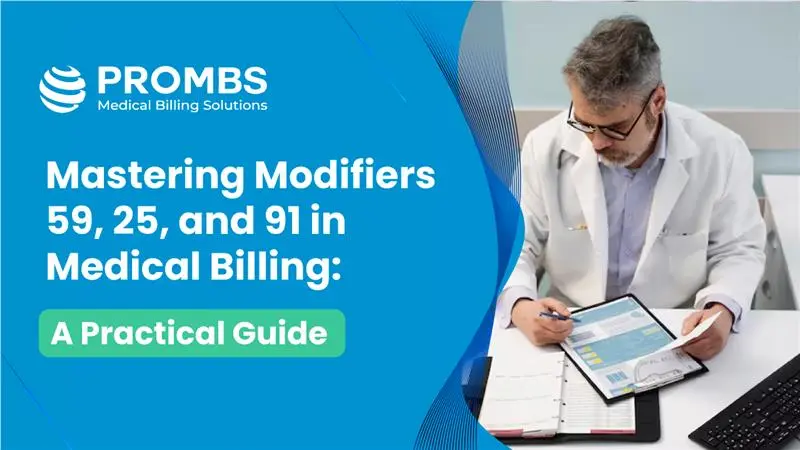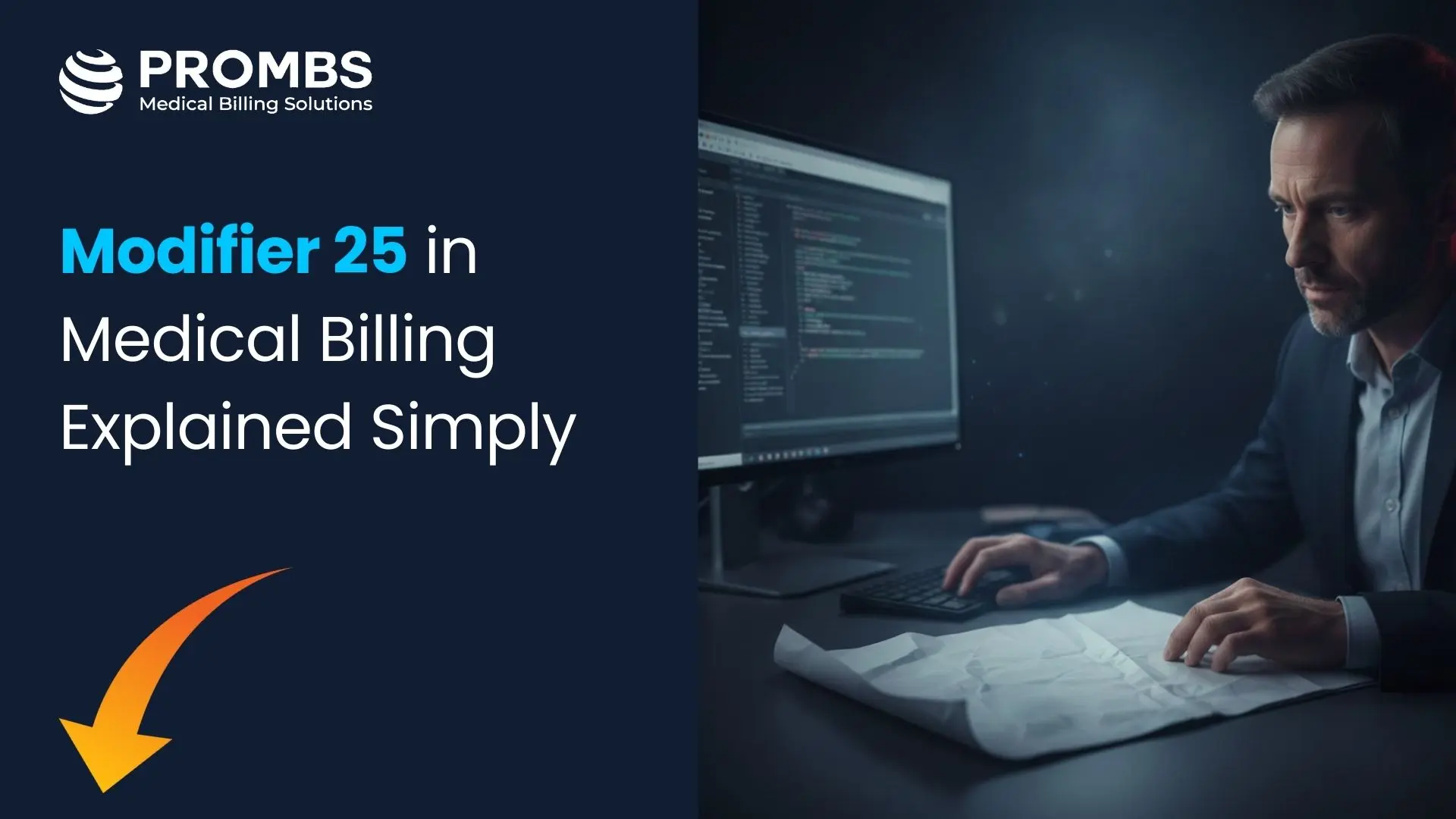What Are Modifiers & Their Role in Medical Billing
In CPT® and HCPCS Level II coding, modifiers are two-character codes (numeric or alphanumeric) appended to a primary procedure or service code. Their purpose is to convey additional information to payers without changing the core meaning of the CPT code itself. Modifiers clarify why a procedure was performed, how it differs from similar services, and whether special circumstances apply.
Accurate modifier usage ensures that:
- Claims pass payer edits (NCCI, MUE) without unnecessary denials.
- Payment accurately reflects the work performed.
- Medical records withstand payer and regulatory audits.
Inaccurate modifier use, on the other hand, is a common trigger for overpayment recoupments, compliance audits, and even fraud investigations.
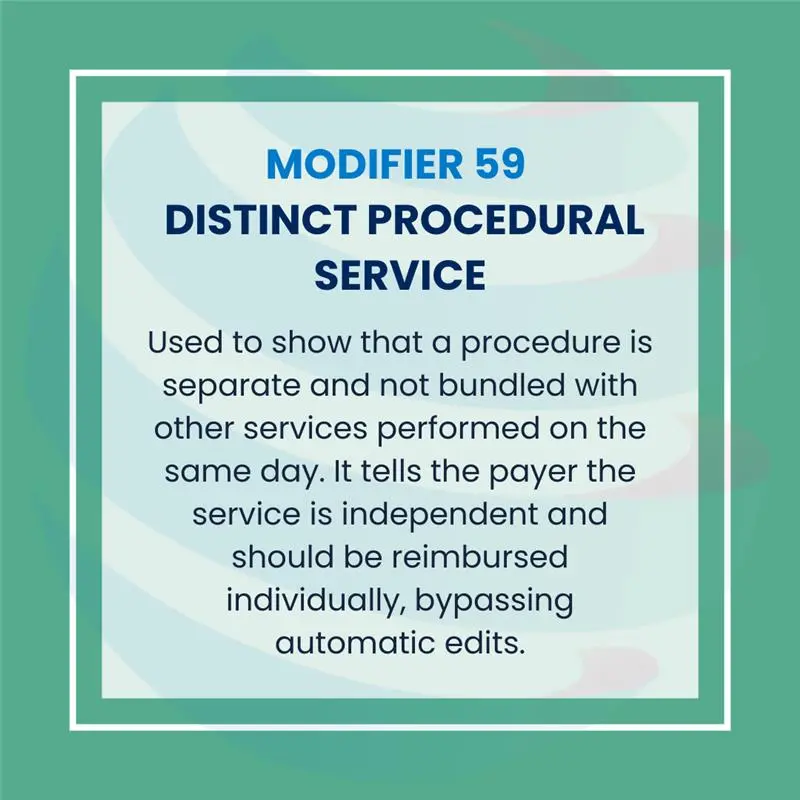
By default, many CPT® codes are subject to National Correct Coding Initiative (NCCI) edits, which bundle services together when they are commonly performed as part of the same procedure. Modifier 59 tells the payer that this case is an exception to the default bundling logic because of clinical and procedural circumstances that justify separate payment.
According to CMS and AMA CPT guidelines, Modifier 59 is applicable when the distinct service:
- Occurs at a different anatomical site – Different limb, organ, or body area.
- Is performed during a separate encounter – A second session on the same date of service.
- Involves a distinct lesion, incision, or organ system – Independent surgical or procedural focus.
⚠ Important: Modifier 59 is considered a modifier of last resort. If a more specific modifier (e.g., XE, XS, XP, XU for Medicare claims) exists, that should be used instead.
Documentation & Compliance Requirements
Accurate and defensible documentation is critical for Modifier 59. Because payers often flag this modifier for audit, the medical record must clearly support its use. The operative note, procedure report, or encounter note should include:
1- Clinical Rationale:
- Why the second procedure was necessary.
- How it differed in purpose and execution from the primary service.
2- Exact Site or Organ System:
- Specify laterality (e.g., left vs. right limb) or distinct body region.
- Indicate if a different incision, lesion, or anatomical structure was involved.
3- Timing Details:
- Whether performed in the same operative session or at a separate encounter.
- Time stamps for procedures done hours apart on the same day.
4- Supporting Evidence:
- Link to diagnostic results, imaging, or pathology that justify the distinct procedure.
- Payer policy citations, if relevant.
💡 Compliance Tip: If a payer requests records for a claim with Modifier 59, absence of clear separation in documentation is the fastest route to denial or recoupment.
Billing Workflow & NCCI Edit Considerations
Correct use of Modifier 59 requires alignment with NCCI edits and payer rules:
Step 1: Code the Primary Procedure
- Assign the CPT code for the main service performed.
- Ensure correct modifiers for laterality or complexity, if applicable.
Step 2: Identify Additional Service
- Verify that the second procedure is not already integral to the primary one per NCCI edits.
- Use the CMS NCCI Edit Table or payer-specific bundling guidelines.
Step 3: Append Modifier 59
- Apply only to the secondary CPT code that would otherwise be bundled.
- Do not place Modifier 59 on both services unless each is distinct from the other.
Step 4: Submit Claim with Justification
- Ensure claim submission includes proper ICD-10 codes linking each CPT to the correct diagnosis.
- For Medicare claims, consider more specific X-modifiers when applicable.
Appropriate Usage Scenarios
Modifier 59 should be used when:
- The same provider performs a separate procedure on a different anatomical site during the same session.
- Two procedures are done at different encounters but on the same date of service.
- A procedure is distinct because of a different incision, lesion, or organ system.
Example – Orthopedics:
Arthroscopy of the right knee followed by debridement of a separate lesion in the left knee.
Example – General Surgery:
Laparoscopic cholecystectomy with separate laparoscopic repair of an unrelated hernia.
Inappropriate Usage Scenarios
Do not use Modifier 59 when:
- The service is part of the global surgical package for the primary procedure.
- A more specific modifier (XE, XS, XP, XU) applies for Medicare claims.
- The second service is inherently bundled under CPT or NCCI rules.
Example – Wrong Use:
Performing a skin biopsy and suturing the same site suturing is bundled into the biopsy.
Real-World Coding Examples
Example 1 – Dermatology:
Example 2 – Gastroenterology:
During a colonoscopy, the gastroenterology team removes a polyp from the ascending colon and performs a separate biopsy in the descending colon. Because the biopsy is at a distinct anatomical site, Modifier 59 is used to indicate a separate and distinct procedural service.
Example 3 – Interventional Radiology:
In interventional radiology, two angioplasty procedures are performed in different arteries during the same session, each requiring a separate vascular access point. Modifier 59 is applied to distinguish the independent nature of the procedures.
Common Mistakes with Modifier 59
- Overuse without clinical justification – Appending Modifier 59 simply to bypass payer edits without a valid reason increases audit risk and leads to frequent denials.
- Using 59 instead of the specific X-modifiers for Medicare claims – Medicare expects XE, XS, XP, or XU where applicable. Using 59 in these cases can cause payment delays or outright denials.
- Insufficient documentation – Failing to clearly record a distinct anatomical site, lesion, organ system, or separate encounter in the operative note or encounter record often results in recoupment during payer audits.
- Applying Modifier 59 to both CPT codes unnecessarily – 59 should be appended only to the secondary, distinct procedure. Adding it to both codes can trigger redundant claim errors.
💡 Pro Insight: CMS and commercial payers track Modifier 59 usage closely. The OIG has repeatedly cited it as one of the top sources of improper payments due to overuse and misapplication.
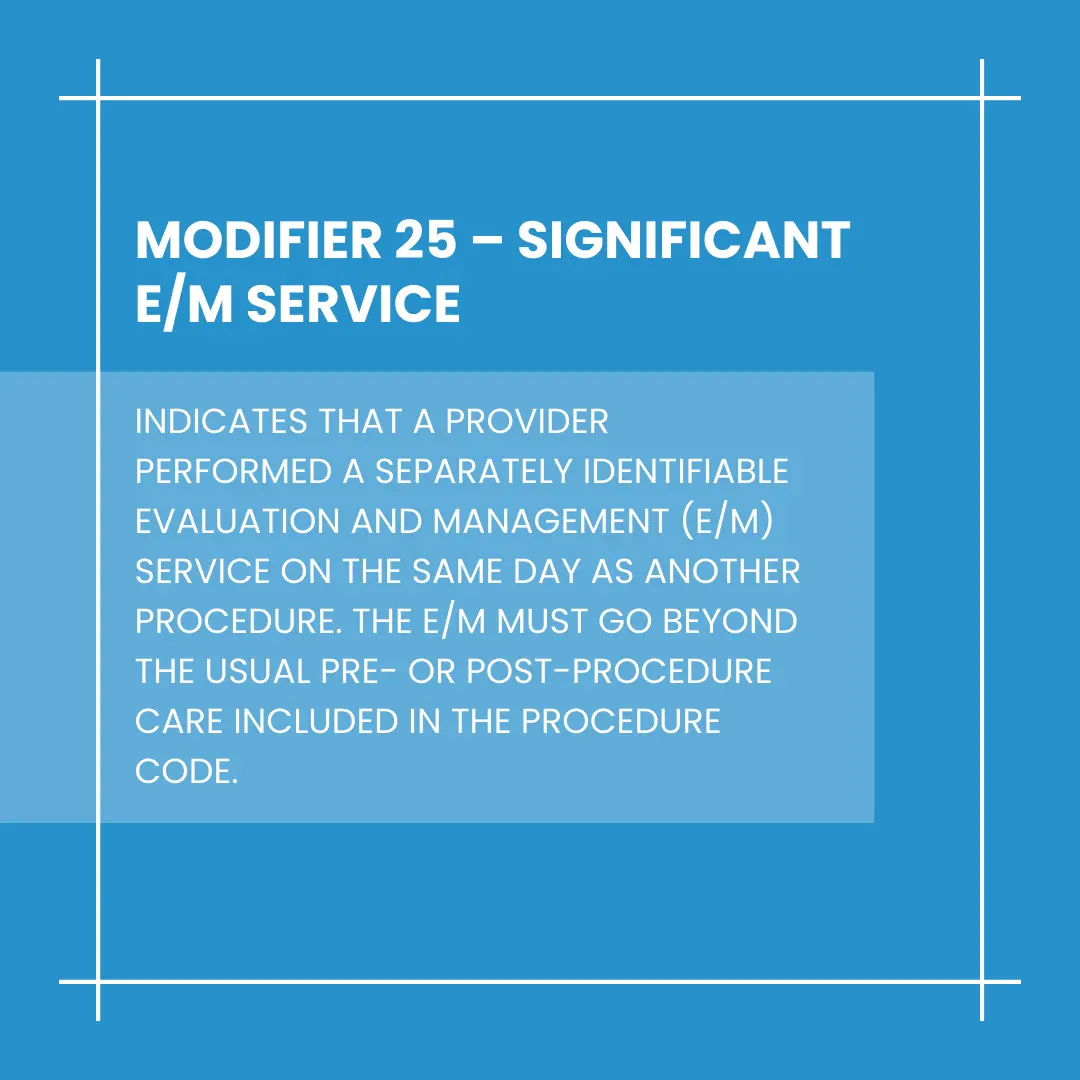
By CPT® guidelines, this modifier allows payment for both the E/M and the procedure when each is clinically necessary and properly documented.
- According to CMS and AMA CPT rules, Modifier 25 applies when the E/M service:
- Addresses a new or unrelated problem during the same encounter.
- Requires significant additional work beyond the usual care for the procedure.
- Is clearly documented as distinct from the pre- and post-service work of the procedure
⚠ Important: Modifier 25 is frequently audited. Insufficient documentation or overuse may lead to denials and compliance risk.
Documentation & Compliance Requirements
The medical record must explicitly show that the E/M service was separate and medically necessary:
1-Clinical Rationale:
- Document why the E/M was necessary in addition to the procedure.
- Explain how it addressed a separate problem or required significant complexity.
2- Detailed E/M Components:
- Record history, exam, and medical decision-making elements.
- Ensure all E/M documentation requirements are met for the level billed.
3- Separation from Procedure Note:
- Keep the E/M documentation distinct from the procedure’s operative note.
- Avoid “combining” the E/M and procedure into one blended note.
4- Linking Diagnoses:
- Use ICD-10 codes to differentiate the E/M diagnosis from the procedure diagnosis when applicable.
💡 Compliance Tip: If the E/M is related to the condition being treated by the procedure and does not require extra work, Modifier 25 should not be used.
Billing Workflow
Step 1: Determine Medical Necessity
- Review the provider’s documentation to confirm that the Evaluation & Management (E/M) service is medically necessary and either:
- Unrelated to the procedure performed on the same date, or
- Significantly beyond the usual pre- and post-operative care associated with that procedure.
- Ensure supporting notes clearly describe the distinct nature of the E/M service.
Step 2: Assign Procedure CPT
- Select and enter the correct CPT code for the primary procedure performed.
- Do not append Modifier 25 to the procedure code; it applies only to the E/M code.
- Verify that the CPT code aligns with the procedure description and payer guidelines.
Step 3: Assign E/M CPT with Modifier 25
- Choose the appropriate E/M CPT code based on documentation and medical decision-making level.
- Append Modifier 25 to indicate that the E/M service was separate and significant from the procedure on the same day.
- Ensure documentation clearly supports the additional E/M work performed.
Step 4: Link Diagnoses Correctly
- Assign the correct ICD-10-CM diagnosis codes for each service.
- The E/M service should be linked to a diagnosis that justifies its separate medical necessity.
- The procedure should be linked to its own relevant diagnosis.
- Avoid linking the same diagnosis to both services unless documentation supports distinct issues requiring separate care.
Step 5: Validate & Submit the Claim
- Run claim edits to ensure CPT, modifier, and ICD-10 combinations meet payer requirements.
- Submit the clean claim electronically to reduce processing delays.
Appropriate Usage Scenarios
- Same-day procedure & unrelated problem: Patient comes in for earwax removal but also complains of chest pain, requiring a separate cardiovascular evaluation.
- Same problem but extra complexity: A patient presents with a laceration that requires suturing, and the provider also spends significant time assessing for concussion after a head injury.
Example – Family Medicine:
Patient scheduled for wart removal also presents with unrelated knee pain requiring full evaluation.
Inappropriate Usage Scenarios
- Using Modifier 25 for a minimal or routine pre-op evaluation for the procedure.
- Applying it when the E/M service is integral to the procedure (e.g., brief history and exam for laceration repair).
- When documentation does not support a significant and separate service.
Real-World Coding Examples
Example – Family Medicine:
A patient scheduled for mole excision also develops acute sinusitis symptoms requiring full examination and prescription. The sinusitis evaluation is billed as an E/M with Modifier 25.
Example 2 – Cardiology:
A patient presents for routine ECG monitoring in the cardiology department but develops acute chest pain during the visit. This leads to a full cardiac workup in addition to the scheduled service. Modifier 25 is applied to the E/M code to indicate a significant, separately identifiable evaluation and management service was performed on the same day.
Common Mistakes with Modifier 25
- Overuse for all same-day E/Ms – Payers audit for abuse when documentation lacks evidence of a significant, separate service.
- Failure to differentiate diagnoses – Not linking separate ICD-10 codes when applicable.
- Bundled services – Using Modifier 25 for services that are inherently part of the procedure.
- Insufficient detail in E/M documentation – Minimal notes that don’t support the billed E/M level.
💡 Pro Insight: Anthem, Cigna, and several Medicare contractors have issued policies requiring submission of office notes for claims with Modifier 25 due to frequent overuse.
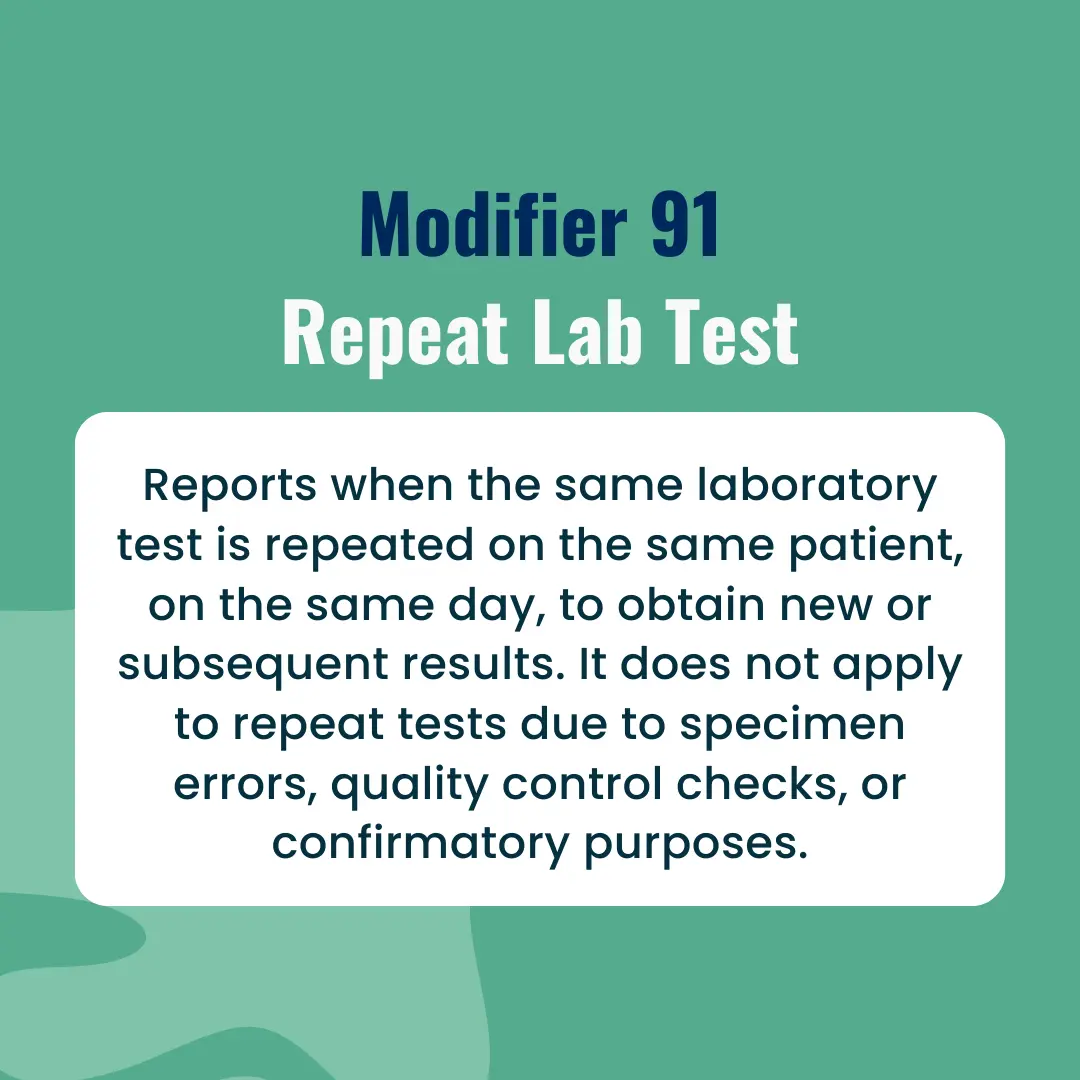
By CPT® and CMS rules, this modifier communicates that repeat testing was medically necessary to evaluate a patient’s condition over time within a single day.
Documentation & Compliance Requirements
The lab report or patient chart should clearly document:
1- Reason for Repetition:
- Clinical justification for multiple same-day test results.
- Example: Serial troponin measurements to rule out myocardial infarction.
2- Test Details:
- Test CPT code, time of each draw, and number of repetitions.
3- Exclusion Criteria:
- Not for repeat testing due to machine malfunction, specimen issues, or quality control checks.
💡 Compliance Tip: Modifier 91 supports payment for medically necessary repeat testing, not administrative or procedural repeats.
Billing Workflow
Step 1: Code the Laboratory Test
- Identify the correct CPT (Current Procedural Terminology) code that matches the laboratory test performed.
- Verify that the code matches the service documented in the patient’s record.
- Confirm that the CPT code is active and valid for the date of service per the current year’s coding guidelines.
Step 2: Repeat Test Coding
- For the second and any subsequent identical tests performed on the same patient and date of service, append Modifier 91 to the CPT code.
- Modifier 91 indicates that the test is a repeat clinical diagnostic laboratory test, not a duplicate billing or clerical error.
- Ensure documentation clearly states why repeat testing was necessary (e.g., monitoring patient condition, confirming initial results).
Step 3: Ensure Diagnosis Linkage
- Link each CPT code (including those with Modifier 91) to the appropriate ICD-10-CM diagnosis code that supports medical necessity.
- Confirm the ICD-10 code aligns with payer policy and the reason for repeat testing is documented.
- If multiple diagnoses apply, sequence them according to clinical relevance and payer rules.
Step 4: Claim Validation & Submission
- Use your practice management or billing software to run claim scrubbing and validation checks.
- Verify that CPT, modifier, and ICD-10 combinations are accepted by the payer’s edits (NCCI, LCD/NCD).
- Submit the clean claim electronically through your clearinghouse for faster processing.
Step 5: Payment Posting & Denial Management
- Once payment is received, post it to the patient account and reconcile with the remittance advice.
- If a denial occurs for repeat testing, review the payer’s explanation of benefits (EOB), correct any coding or documentation issues, and resubmit if appropriate.
Appropriate Usage Scenarios
- Serial glucose monitoring for diabetic ketoacidosis management.
- Multiple same-day potassium levels for patients on IV potassium replacement.
- Repeated INR measurements during warfarin dose adjustment in unstable patients.
Inappropriate Usage Scenarios
- Repeat testing due to equipment malfunction or specimen issues.
- Quality control or proficiency testing repeats.
- Separate specimen collection for unrelated diagnoses on the same day (code without Modifier 91).
Real-World Coding Examples
Example 1 – Cardiology:
Serial troponin measurements at 0, 3, and 6 hours are performed to evaluate myocardial injury, a critical diagnostic step in cardiology for detecting and monitoring acute coronary syndromes.
Example 2 – Nephrology:
In nephrology, multiple serum creatinine measurements are obtained during the management of acute kidney injury to monitor dynamic changes in renal function. Modifier 91 is applied to indicate repeat laboratory testing for ongoing clinical assessment.
Common Mistakes with Modifier 91
- Using for retesting due to lab errors – Should not be billed; these are not reimbursable.
- Applying to different tests – Modifier 91 only applies to the same test repeated, not different tests in a panel.
- Omitting medical necessity – Lack of documentation for why repeat testing was required leads to denials.
Comparative Analysis Table – Modifiers 59 vs 25 vs 91
| Feature | Modifier 59 | Modifier 25 | Modifier 91 |
|---|---|---|---|
| Purpose | Distinct procedural service | Significant, separately identifiable E/M | Repeat lab test |
| Code Type | Procedure CPT/HCPCS | E/M CPT | Lab CPT |
| Key Justification | Different site, encounter, or lesion | E/M above usual pre/post-procedure work | Repeat test for new results |
| When Not to Use | Bundled services, global package | Pre-procedure E/M only | Lab error repeats |
| Documentation Focus | Site, encounter, distinctness | Separate history, exam, MDM | Medical necessity, time stamps |
Conclusion
Accurate and compliant use of Modifiers 59, 25, and 91 is essential for optimizing reimbursement, passing payer audits, and avoiding costly denials or recoupments. While each modifier serves a unique purpose unbundling distinct procedural service, capturing significant E/M work on the same day as a procedure, or documenting medically necessary repeat lab testing, the common thread is precise documentation, correct CPT/ICD-10 linkage, and alignment with payer-specific rules.
In today’s regulatory environment, misuse or overuse of these modifiers is a leading cause of payment delays and audit exposure. Coders and billing teams should be proficient in identifying appropriate scenarios, differentiating between similar modifiers, and justifying each claim with defensible documentation. When applied correctly, these modifiers not only secure accurate payment but also demonstrate a provider’s commitment to compliance and clinical integrity.
